
Analipus japonicus
Fir Needle, Bottlebrush Seaweed, Sea Fir
23 July 2024
Big Beach, Vancouver Island, B.C., Canada
Tide: 0.2 feet at 08:45 PDT (measured at Ucluelet Tidal Station)
Weather: Mainly sunny (10 % cloud cover), wind West 0 – 5 km/hour, sea smooth, low westerly swell, humidity 94%, 15 ˚C.
Moon: Waning Gibbous (93.5%, 18 days); Next Phase, Third Quarter, 27 July 2024 at 7:51 pm PDT; Previous Phase, Full Moon, 21 July 2024 at 3:17 am PDT.
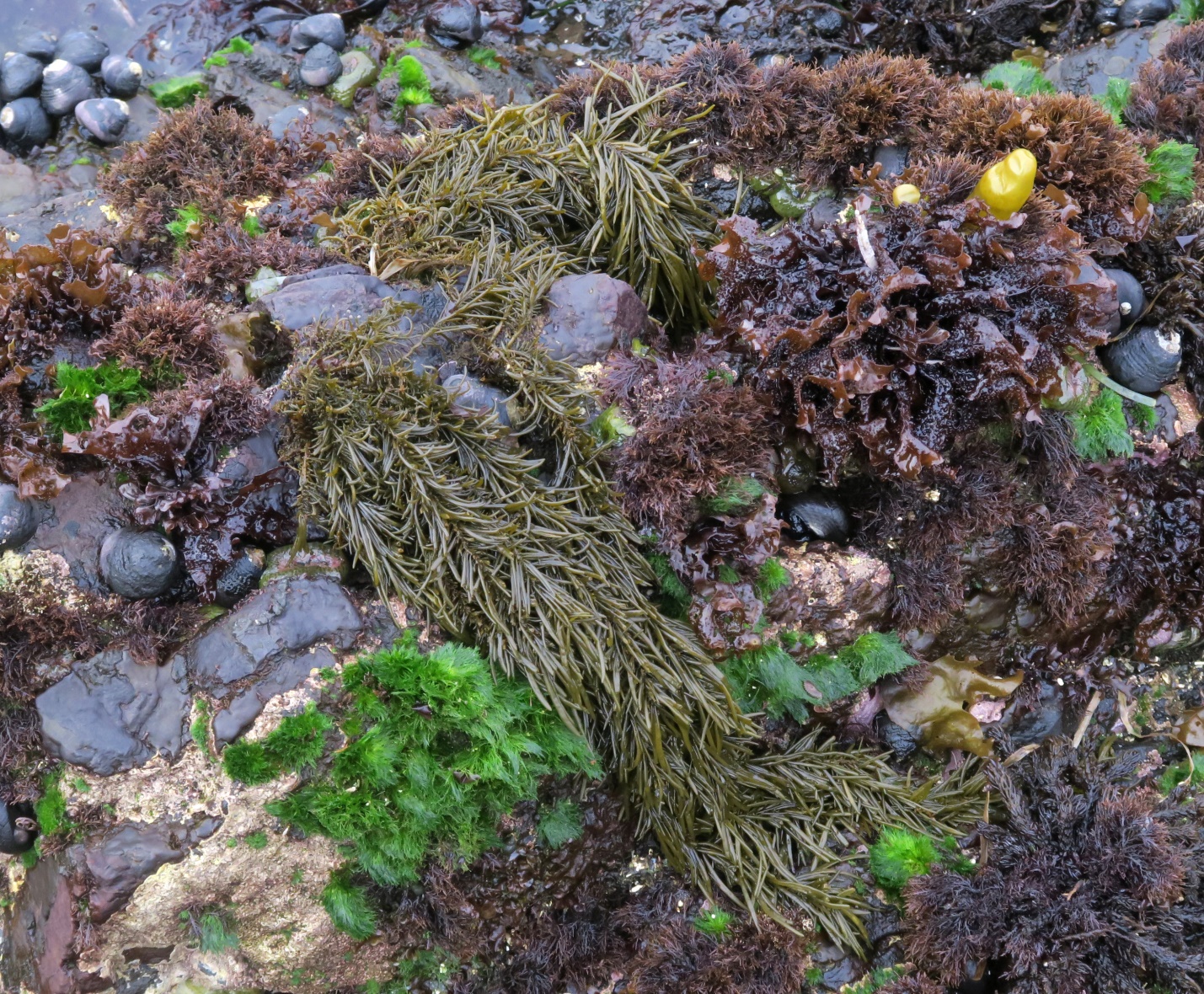
Figure 1: Splayed across the rocks amongst other mid-intertidal species is the olive green colored seaweed that looks somewhat like a ‘fir branch’; in the world of phycology it is a brown alga known as Analipus japonicus. Big Beach, Vancouver Island, B.C., Canada. July 22, 2024. Photo ID 27713 ©Seaweedwhisperings.com
Person 1:
Looks almost like a hemlock branch with needles, certainly conifer-like.
Seems to like to be perched atop bedrock ridges, but not on the “highest” peaks. They’re fine living in the foothills and do not seek the mountain top exposure.
Not dominant, not subservient.
Not demanding, also doesn’t want to be demanded of.
Lives in the mid-intertidal.
Knows how to be showy when it wants to.
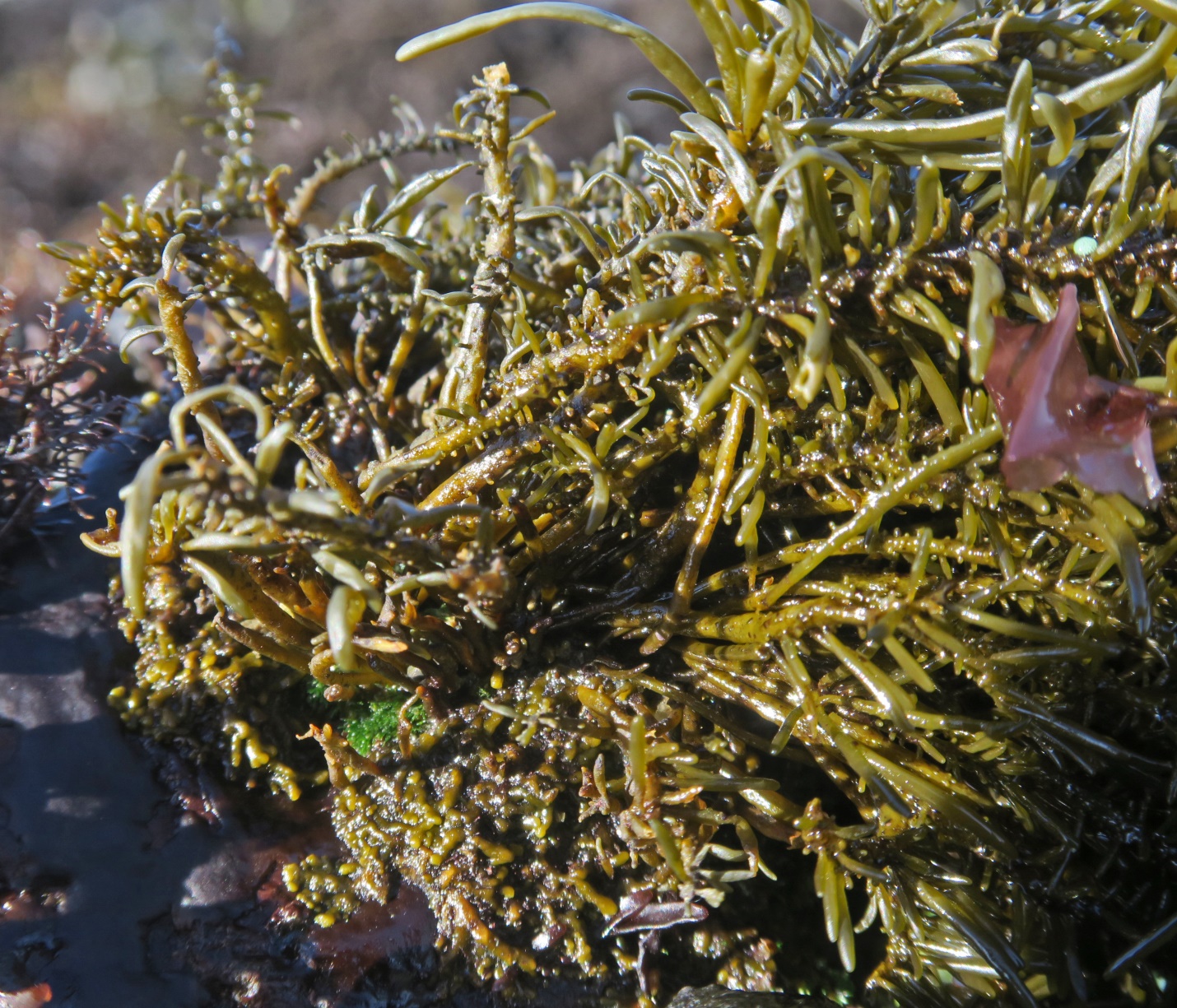
Figure 2: Zoomed in here for look at the base of the seaweed, you can see the knobby texture of a portion of the perennial crustose holdfast. While the holdfast may be perennial, we have not found that the each year will be suitable for new growth of the erect thalli with their ‘fir’ needle branches. Or possibly they have often been damaged or grazed and are difficult to find before they would naturally die back in the fall. Big Beach, Vancouver Island, B.C., Canada. July 22, 2024. Photo ID 27714 ©Seaweedwhisperings.com
Person 2:
Mid intertidal.
On rocks.
Growing from a holdfast comprised of small knobby rhizomes that are all tightly adhered as a crust to rock.
There are lovely and healthy Analipus japonicus individuals at this location – they seem vital and fully in their prime.
Thallus has a long main axis and spiraled around it are branchlets; branchlets are of many varying lengths – some less than or about 1 cm and some even as long as 8 cm.
At low tide this seaweed lays prostrate on the rocks and I noticed that I just decided to do the same myself. With this is the feeling of ‘all is good’ and it didn’t feel like lying down out of exhaustion but more like an invitation to ‘relax and enjoy this place and time of plenty’. This type of energy emanates from Analipus japonicus today. Here it is doing really very well. It seems to have few worries and an abundance of what it needs.
Certainly I’ve never found healthier looking individuals than these today at Big Beach.
You’re not quite at the tops of the rocks that you choose to grown on, Analipus, but just over the top. Here you don’t stand out at the pinnacle where you’d be an easy target for damage or attack, but you are still quite high up – you have a lovely view, and you can drape over and down.
The draping over and down feeling is one that has a kind of confidence to it. So, they aren’t hiding, even though they aren’t at the “top” of the rocks.
Wet and fresh this seaweed certainly can look quite like certain conifer tree branches.
In certain conditions and certainly when you are drier from exposure to air you are darker brown, blackened, and you seem to be a bit diminished. You don’t like feeling diminished, do you, Analipus? No, not at all, but you can tolerate it for short periods and it spurs you to regain your previous confidence and draping over beauty.
We’ve never found a lot of you in any one area – this is the most we’ve encountered so far. Are you picky? Or do you have a way of being that is not so common to achieve and maintain? Therefore, one that isn’t found frequently?
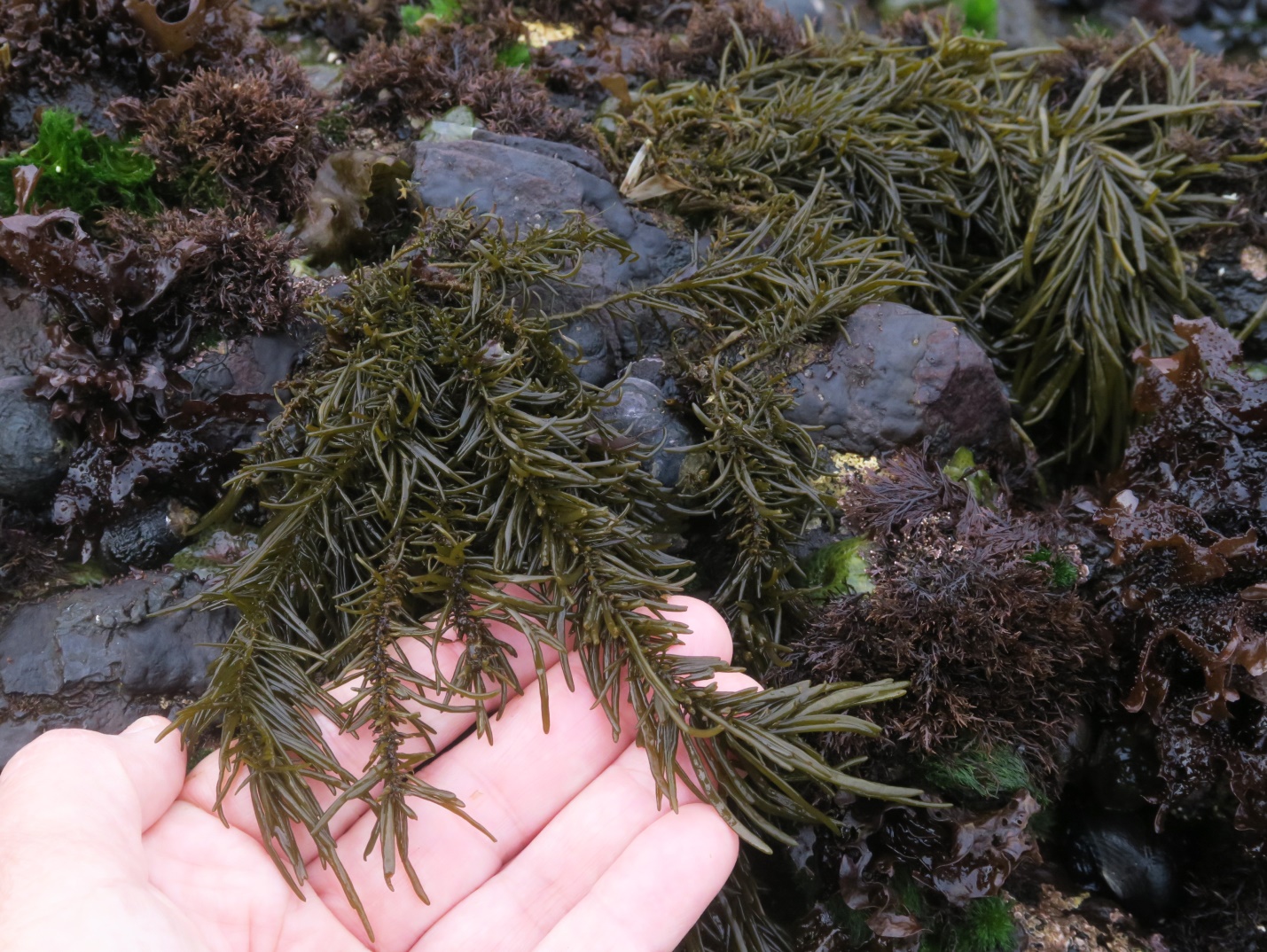
Figure 3: At Big Beach in late July of 2024 this Analipus japonicus looked to be in excellent shape. Big Beach, Vancouver Island, B.C., Canada. July 22, 2024. Photo ID 27715 ©Seaweedwhisperings.com
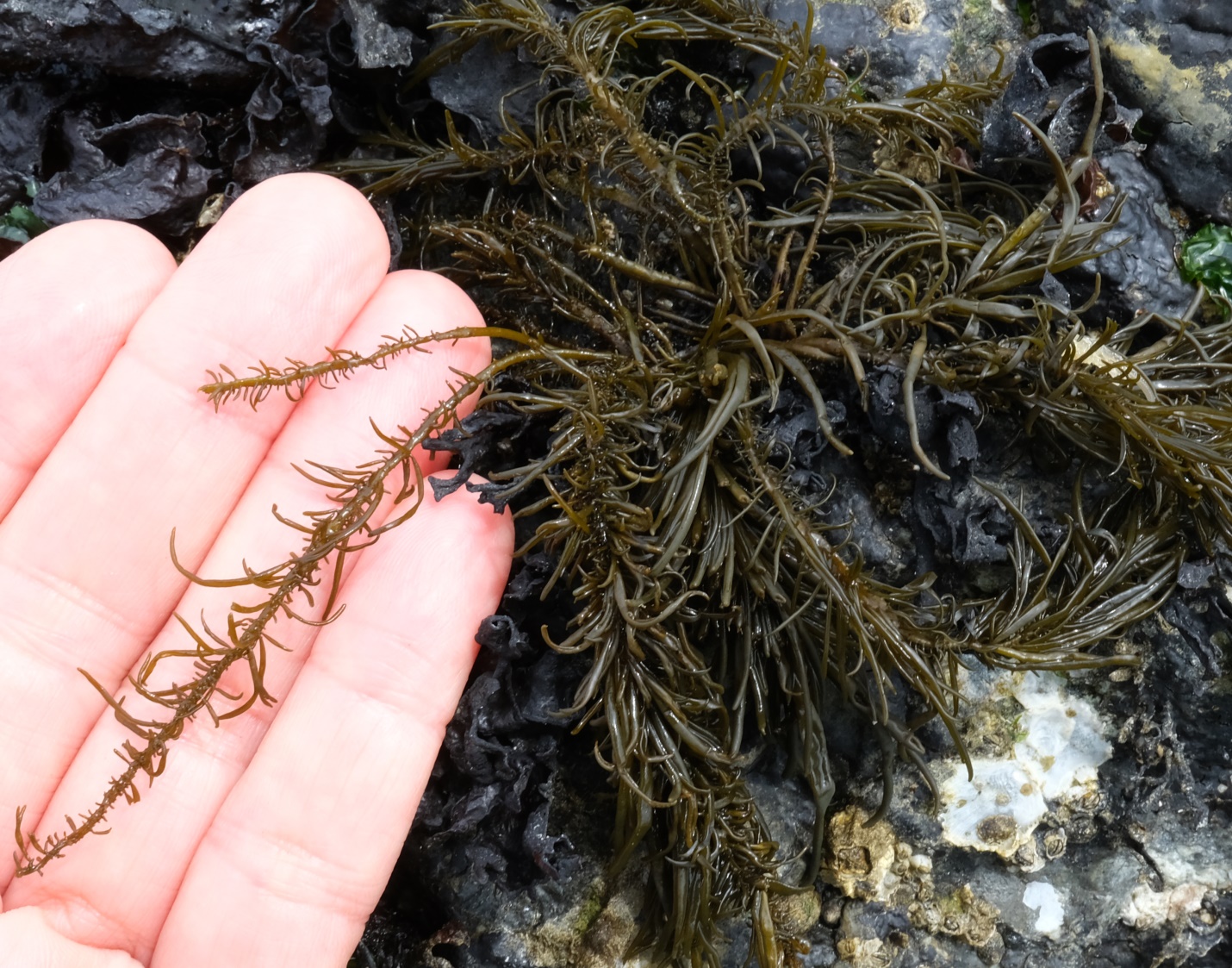
Figure 4: At Harling Point in early June of 2022, this individual is displaying the thalli in various stages of development. Harling Point, Juan de Fuca Strait, Vancouver Island, B.C., Canada. June 2, 2022. Photo ID 27716 ©Seaweedwhisperings.com
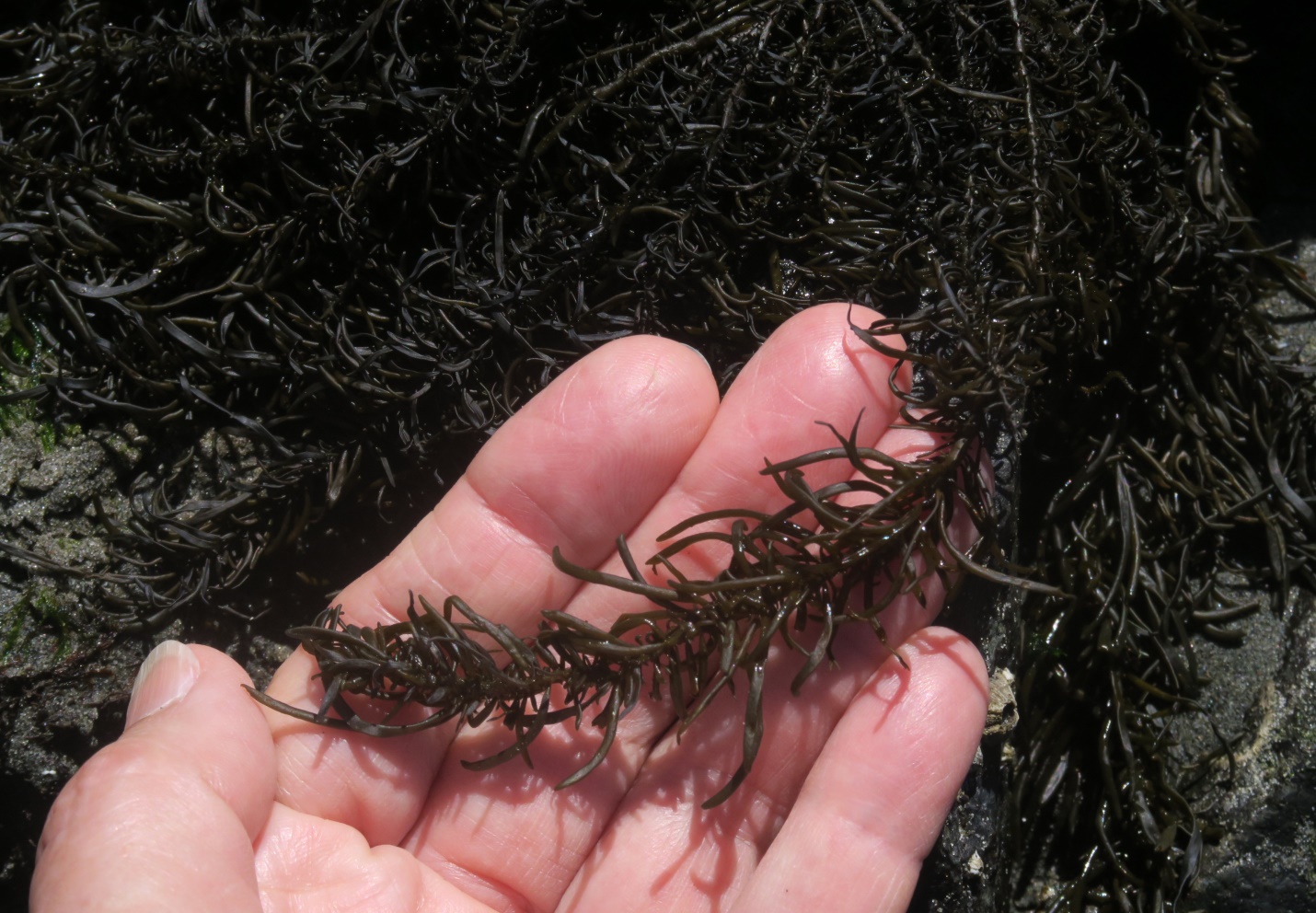
Figure 5: At Fishboat Bay early June of 2024 this Analipus japonicus individual was found looking as if it was a bit ‘distressed’ and blackened after having been exposed in the warm summer hours of low tide for a few consecutive tide cycles. Fishboat Bay, Juan de Fuca Strait, Vancouver Island, B.C., Canada. June 7, 2024. Photo ID 27717 ©Seaweedwhisperings.com
Discussion:
Whenever we’ve located this seaweed, it has only been upon close observation of the intertidal zone. It does NOT stand out from a distance. Closer up, however, it is quite distinctive. Its form contrasts with the forms of basically all the other seaweeds in its neighborhood. Very few things are truly similar and possibly only Neorhodomela larix, Black Pine, is remotely similar in looks.
We’ve wondered also why we’ve never really found areas richly inhabited by this species. Perhaps certain habitat needs are not met or possibly it is largely out-competed in our area.
Maybe they “require” a lot of resources; it seems that they don’t do well with extreme adversity, and conversely, they will do very well when conditions are perfect.
This feels like it could be an ephemeral type of existence – that it is looking for certain conditions at the right time. Our feeling was that one year it may be on this rock, the next year it is on some other rock, and rarely is it to be seen in the same location. This is quite different than Postelsia palmaeformis that persists in the same place year after year – the Sea Palm’s is a narrow niche, but they regularly inhabit and thrive in it. Analipus japonicus seems to become possibly dissatisfied with its choice of home and so will move in search of a better place. They don’t remain stuck and “settle for less” but will pack up their bags and move to where they think they can do better. This trait ties in with the observation that they do not enjoy feeling “diminished” in any way. They would prefer to risk pioneering a new area than to remain loyal to a particular site and thereby slowly fade into ruins.
Their ‘needles’ are many different lengths. Possibly this enhances their ability to move in all directions, to reach and touch many different areas with just the right-sized ‘arm’.
It feels that sometimes this seaweed has “taken up roots” in a neighbourhood that it doesn’t quite fit in with. An observer might notice this and ask, “What are you doing in this area?” But for Analipus japonicus they are busily and thoroughly engaged – they have their purpose in being there.
It is true, however, that this purpose can expire or be fulfilled. Then it’s time to move on and this seaweed does so with satisfaction for a job well done and anticipation and confidence for the next one.
Sometimes it feels, too, that one could see this seaweed and think, “Have I seen you somewhere else before?” But the new setting can give one a slight pause in recognizing them.
Notable in this energy is the absence of regret. Their life is a series of accomplishments well met.
And while their chosen work will not necessarily be the very pinnacle or showiest levels, it can often provide the stable foundation for higher endeavours. They don’t feel diminished if those higher endeavours are carried out by others, instead they take pride in what they have done to create such a possibility.

Figure 6: Here it is, at this site and for this season, Analipus japonicus forms a part of the local intertidal algal community. Will we find it here again next year? Likely not… just why that is may well have been now understood by phycologists but it felt to us as if this seaweed actually is one that will willingly “pack up” and move to new sites. Big Beach, Vancouver Island, B.C., Canada. July 22, 2024. Photo ID 27718 ©Seaweedwhisperings.com
Biology & Natural History Information:
Description:
Thallus is light to dark brown with numerous radially arranged lateral branches, which are cylindrical to distinctly flattened are somewhat curved at the ends. Axes and branches are at first solid, later becoming solid. This species has a distinctive bumpy textured perennial crustose base which serves as the holdfast and grows to 5 cm in diameter; it can persist for several years. The erect axes appear in March at all latitudes and then die back in the fall. Reproduction is chiefly asexual and takes place from July to November. Unilocular sporangiate plants occur very rarely (noted only from a few locations) and only in June and July. Plants bearing plurilocular sponangia are abundance from July to November.
Habitat:
Analipus japonicus occurs in the mid to low intertidal (some sources suggest upper to mid-intertidal) on rock and prefers semi-protected to exposed habitats. Some sources suggest it prefers moderate to heavy wave action and this fits all the locations we have found it at on Vancouver Island.
North Pacific Distribution:
Aleutian Islands, Alaska, to Point Conception, California; Korea; Japan; Russia.
Remarks:
The golden bottlebrush epiphyte, Saundersella simplex, often grows on Analipus japonicus can dominate its host obscuring it nearly completely from sight.
The type locality for Analipus japonicus is Hakodate, Hokkaido, Japan.
Classification:
Empire: Eukaryota
Kingdom: Chromista
Phylum: Heterokontophyta
Subphylum: Ochronphytina
Class: Phaeophyceae
Subclass: Fucophycidae
Order: Ralfsiales
Family: Ralfsiaceae
Genus: Analipus
Species: Analipus japonicus (Harvey) M.J.Wynne 1971
Former name(s):
Homotypic synonym: Halosaccion japonicum Harvey 1857. Heterotypic synonyms: Chordaria abietina Ruprecht ex Farlow 1875; Heterochordaria abietina (Ruprecht ex Farlow) Setchell & N.L.Gardner 1924.
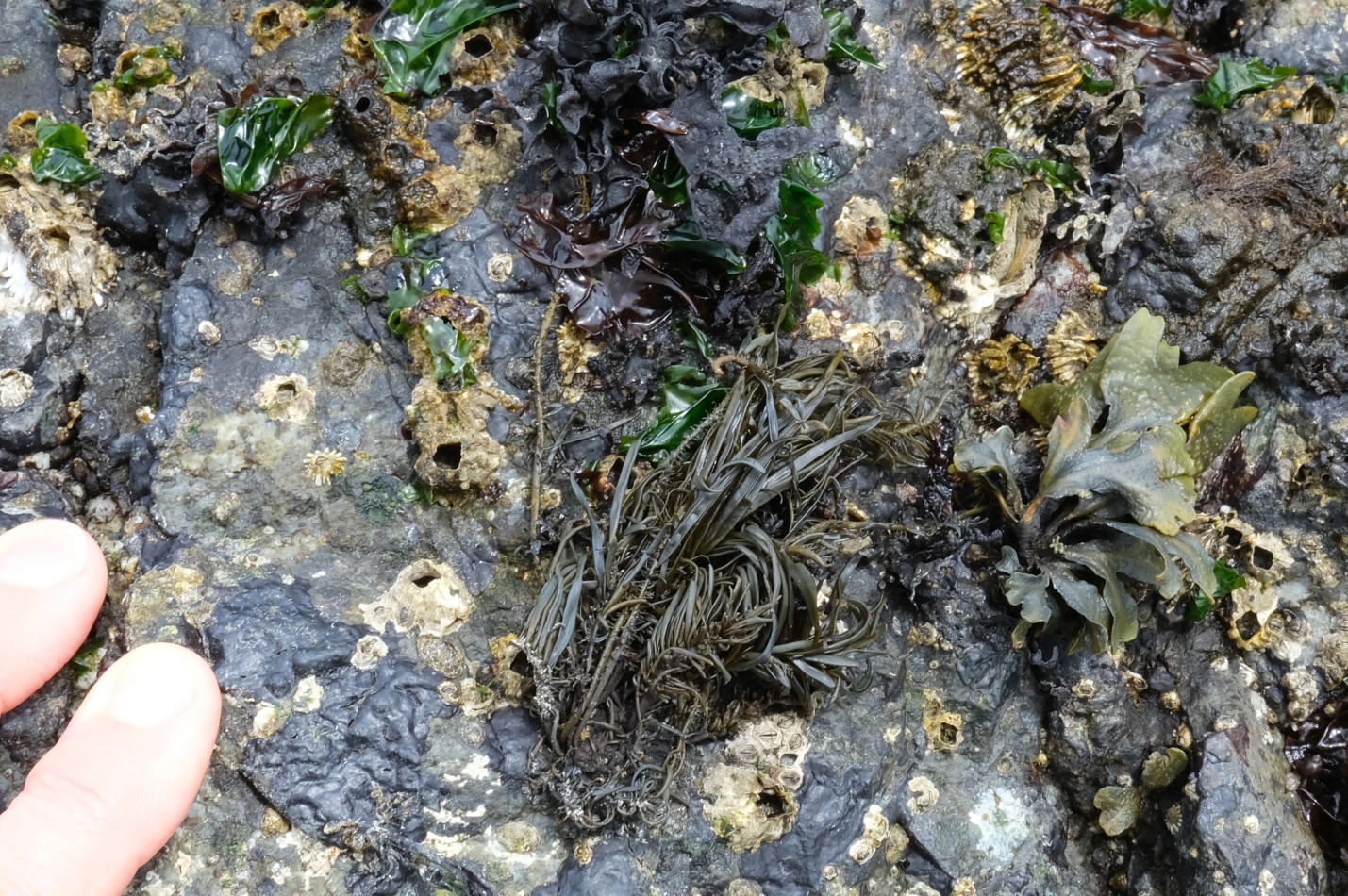
Figure 7: Yet another Analipus japonicus is growing adjacent to some Mastocarpus spp. crusts (dark black tar-like areas) and some young Fucus distichus. Human fingers show relative size and the branch length of this individual is quite varied. The flattened fir-needle look is also evident. Harling Point, Juan de Fuca Strait, Vancouver Island, B.C., Canada. June 2, 2022. Photo ID 27719 ©Seaweedwhisperings.com
![]()